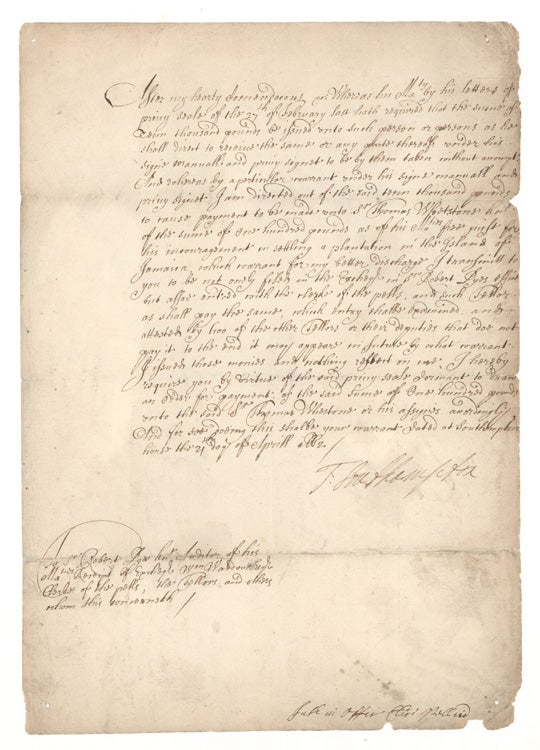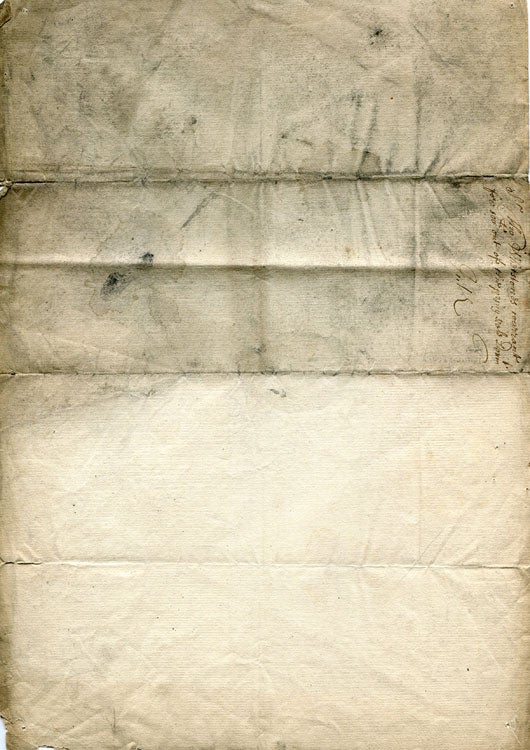Document Signed. 1662 privy seal warrant issued to future Jamaican privateer and Speaker of the Jamaica House of Assembly, Sir Thomas Whetstone.
[Southampton House, England]: 21 April 1662.
Price: $6,500.00
About the item
1 bifolium, (11-3/4 x 8-1/4 in.), accomplished entirely in manuscript. Docketed verso: “Sr Tho. Whetstones warrant for £100 out of the privy seals dormant. [indistinct initials follow].”. 1 vols. 4to. Former fold lines, per usual; some surface soil to recto of document; heavy surface soil to verso of integral cognate; small perimeter chips and light distress. See ODNB; Marley, Pirates of the Americas, pp. 399–405.
Item #250234
According to David F. Marley’s Pirates of the Americas, Sir Thomas Whetstone (1630/31–1668?) was a nephew of Oliver Cromwell “reduced from a Commonwealth naval Commodore into an impoverished West Indian rover, before dying in Spanish hands.”
Whetstone is described by ODNB as a naval officer and adventurer and a son of the favorite sister of the protectorate. Through nepotism per the protector’s “misplaced patronage” Whetsone quickly rose through the naval ranks. He ascended from a volunteer on Penn’s flagship in the 1654 expedition to Hispaniola, was given command of a ship on the return voyage home, and eventually commanded a squadron cruising the waters between Malta and Crete.
Whetstone soon became a man of questionable integrity. He flouted orders, sold grain seriously needed to sustain the fleet for his own profit, quarreled with officers and, in general, showed high levels of insolence, incompetence, and dallied onshore, avoiding naval duties.
Cromwell’s death changed Whetstone’s fortunes. When it became apparent to political forces that his usefulness as a pawn to control the naval fleet was insignificant, Whetsone returned to England at the restoration, impoverished and spent. By 1661 he was in a debtor’s jail in Marshalsea where he became a royal nuisance by “bombarding” the government for employment and begging relatives for money. Finally, to put this embarrassment out of harm’s way, the King agreed in April 1662 to give Whetstone £100 and to establish him as a Jamaican planter. The money was considered “royal bounty for his encouragement in settling a plantation in the Isle of Jamaica.” Additionally, Whetsone was given twelve indentured men to help him establish a foothold in the New World.
Here, then, is the material evidence that propels Whetstone towards his destiny in the West Indies. The document is signed “T. Southampton” by Sir Lawrence Tanfield, Earl of Southampton, Keeper of the Privy Seal. Addressed to and directing Sir Robert Pye, auditor of the exchequer, and indicating that he is to give Sir Thomas Whetstone £100 “… as of his Majesty’s free gift for his incouragement [sic] in settling a plantation in the Island of Jamaica.” With this document, a new chapter in Whetstone’s life opened upon his arrival in Jamaica in 1662.
As Marley notes, Whetstone’s first actions in the West Indies was not to become a sedentary planter, but to be a privateer. With an Indian crew he began operating and raiding off the Cuban coast. Then, personally providing recent intelligence to the infamous Sir Christopher Myngs (1625–1666), an English admiral and pirate whose riotous atrocities with his buccaneers were legendary, Whetstone joined in Myngs’ 1662 sacking of Santiago de Cuba. Myngs was hated by the Spanish and famed for his unbridled cruelty. His atrocities next year in 1663 with pirates Henry Morgan and Abraham Blauvelt would alarm and forced King Charles II to call for a moratorium on further attacks. In the same year, Whetstone was likewise endeavoring: on record as commander of a 7-gun Spanish prize, manned by sixty souls, and noted as one of the “private ships of war belonging to Jamaica.”
In addition to his exploits at sea, Whetsone was heavily involved with the arrest and deposal of the Jamaican Speaker of Assembly, Samuel Long, on charges of treason in 1664. By 1666, Whetsone himself became Speaker of the Jamaica House of Assembly. Circa this period, he was captured by the Spanish on Providencia Island, carried as a prisoner to Portobelo, and then force-marched to Panama City where he was tossed in the dungeon. So angry were the Spanish at Whetstone’s piratical depredations, the Governor Juan Perez de Guzman wrote to Madrid blaming the man for planning “all the damage done on these coasts.” Whetsone died in Spanish captivity in 1667.



